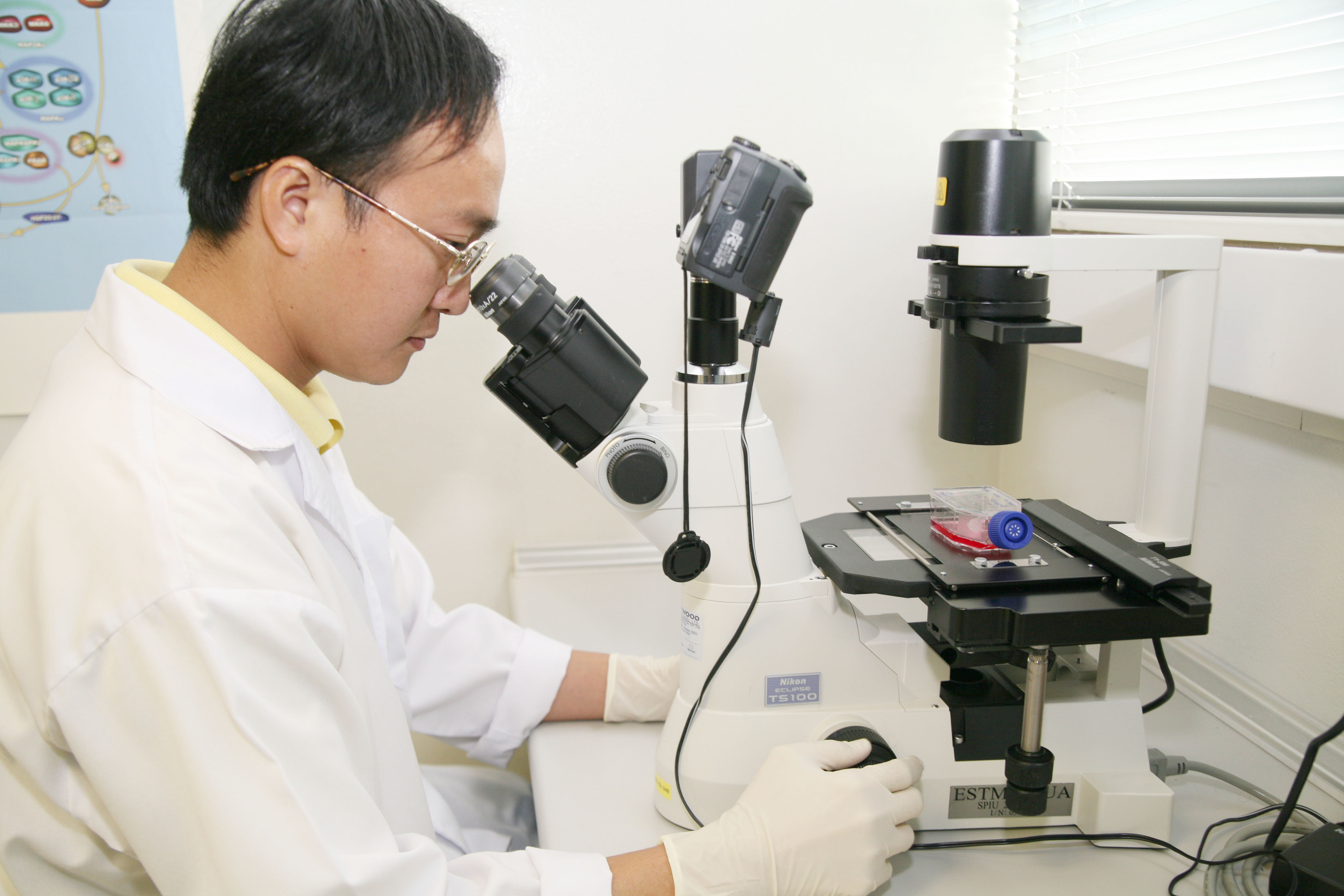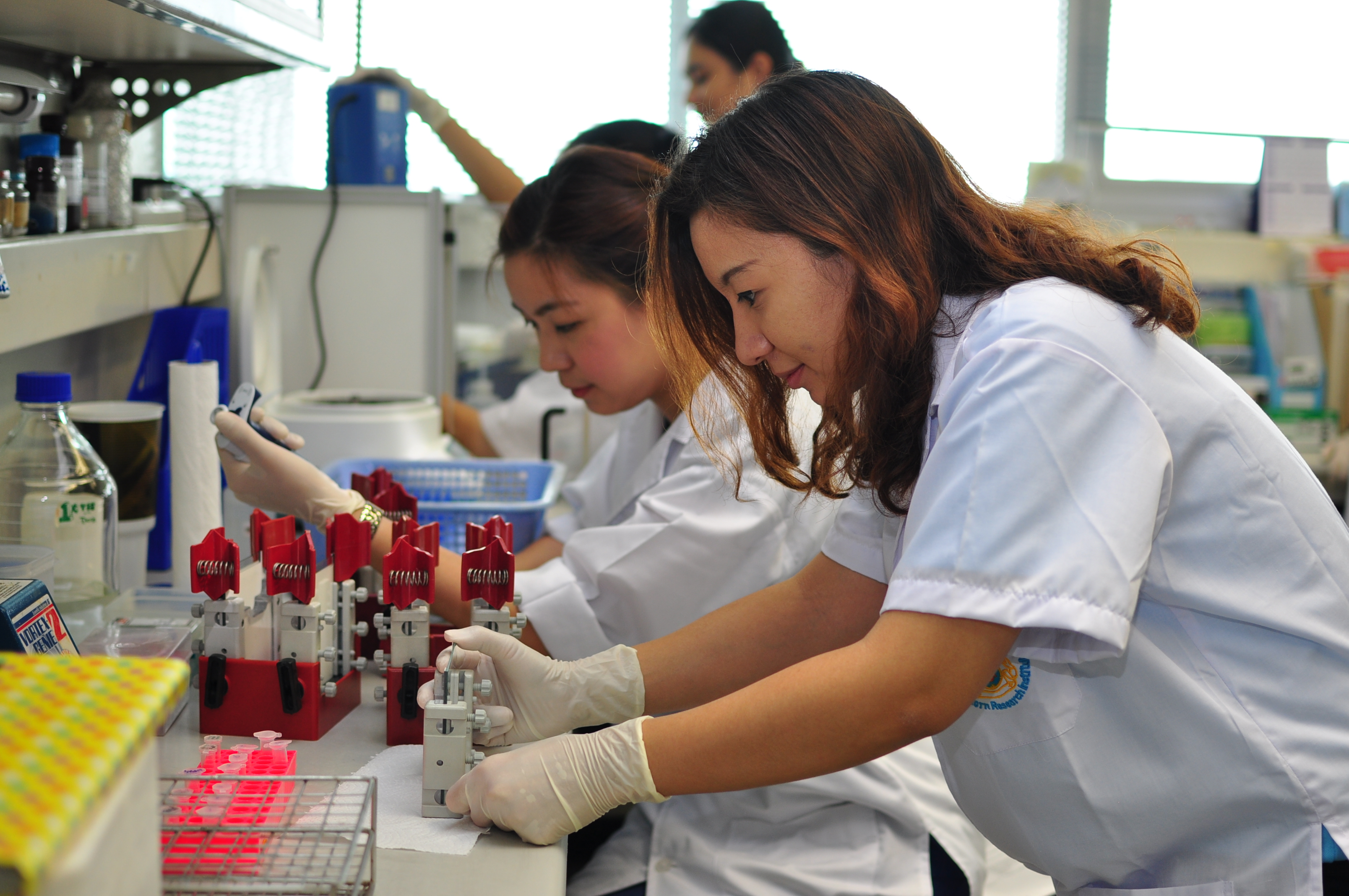Anti-Cancer Agents and Tumor Microenvironment
As the tumor grows, it becomes hypoxic, inducing the tumor to form new blood vessels (angiogenesis) to provide oxygen and nutrients. Cancer cells can also acquire invasiveness, leading to metastasis or spread of cancer to other tissues, which makes treatment even more difficult. This can occur anytime, while cancer cells are in the body. Cancer cells may develop resistance to drugs, either before or during chemotherapeutic treatment. Two major problems of cancer therapy, namely metastasis and drug resistance, are associated with adaptation of cancer cells to the microenvironment, such as hypoxia, growth factors and cytokines, extracellular matrix changes, and loss of cell attachment. Research in our laboratory covers many of these problems and often uses different cell culture conditions to provide models of these problems and cellular processes, as well as to explore natural products or synthetic agents for development of novel anti-cancer drugs.


Anti-cancer Agents
Conventional chemotherapy can cause toxicity, and is typically administered for intermittent short periods. An alternative approach is to use non-toxic agents which may be used for long-term treatment to prevent or suppress cancer cell invasion. We have screened many plant extracts for non-toxic compounds, which inhibit invasion of cancer cells, since they may have potential as anti-metastatic drugs. Extracts of Helixanthera parasitica and Eclipta prostrata inhibited invasion and migration of cancer cells in vitro, but could not be further purified. Later, vanillin, the flavoring agent in vanilla, was found to inhibit invasion of 4T1 mouse breast cancer cells in vitro. Vanillin also reduced in vivo metastasis of the breast cancer cells in BALB/c mice, when orally administered for one month. Further study using human A549 lung cancer cells showed that vanillin disturbed signal transduction regulating invasion, by selectively inhibiting Akt phosphorylation, as well as inhibiting the enzymatic activity of phosphoinositide 3-kinase (PI3K). Metastatic growth requires VEGF to induce angiogenesis to support oxygen and nutrients. Another compound, chrysin, a flavonoid isolated from Thai propolis, also suppressed metastasis progression of breast cancer cells in mice. Chrysin retarded the growth of metastatic colonies of breast cancer in lungs by inhibiting hypoxia-induced STAT3 activation which is necessary for VEGF gene expression.
Photodynamic therapy: Photodynamic therapy (PDT) has emerged as an alternative chemotherapy that uses energy of visible light to trigger activation of photosensitizer for killing cancer cells. PDT uses a photosensitizer, which by itself has little or no cytotoxicity, but upon irradiation with light, generates reactive oxygen species (ROS) to destroy cells. The advantages of PDT compared to conventional therapies are the minimally invasive, local destruction of tumors, and repeatability for treatment of cancer recurrence. However, a limitation of PDT is the lower water solubility of almost photosensitizers. Therefore, polymeric nanoparticles have been used to improve delivery of the hydrophobic sensitizers to tumors. We showed that photosensitizer-encapsulated polymeric nanoparticles exhibited no cytotoxicity in the dark, but effectively killed HT-29 colon cancer cells and FTC-133 thyroid cancer cells in vitro when irradiated with light.
Drug Resistance
We have established two different models for studying the development of drug resistance in cancer cells. To mimic drug resistance during chemotherapy, a repeated drug treatment approach was used to establish a multidrug resistant lung cell line A549RT-eto, which exhibited 28-, 5-, and 3-fold higher IC50 for etoposide, doxorubicin, and paclitaxel, respectively, compared to parental A549 cells. Real-time PCR, Western blot analysis, and flow cytometry indicated that the cell line showed increased expression of a multidrug transporter, P-glycoprotein (P-gp/MDR1), which pumps out anti-cancer drugs. Interestingly, screening of synthetic compounds led to the discovery of three benzo[α]quinolizin-4-one derivatives, which decreased drug resistance.
Drug resistance is also frequently observed in advanced stage cancer patients, who have never previously received chemotherapy. We established a metastasis-associated drug resistance model by culturing H460 lung cancer cells as floating cells under non-adherent conditions that mimic floating of cancer cells during metastasis through blood or lymphatic circulations. The H460 floating cells rapidly acquired paclitaxel resistance, with 15-fold increase in IC50 for paclitaxel, with the underlying mechanism involving alteration of beta-tubulin isotype expression.
Change in microenvironment: As the tumor grows, changes occur in tumor microenvironment, including growth factors, cytokines, and extracellular matrix, which can affect the behavior of cancer cells. We have shown that hepatocyte growth factor enhanced the aggressiveness of HepG2 liver cancer cells, so that they undergo “vasculogenic mimicry” (VM), whereby tumor cells can form blood channels in the absence of endothelial cells. The creation of VM capillaries in vitro occurs through the induction of a cellular change from epithelial phenotype to mesenchymal phenotype, known as the “epithelial-mesenchymal transition” (EMT). Aggressive tumor cells such as SK-Hep-1 liver cancer cells can spontaneously form VM channels without additional stimuli, and this VM confers resistance to conventional anti-angiogenic therapy, and can promote spreading of cancer cells. Our studies suggest that VM is decreased by compounds inhibiting invasion, such as curcumin. We are also studying the influence of extracellular matrix components on the resistance of cancer cells to drugs. Thus, we found that A549 cells exposed to extracellular matrix proteins exhibited some characteristics similar to those found in dormant cancer cells, including a decrease in cell proliferation, cell motility and invasion, and an increase in chemoresistance for the drugs that target actively proliferating cells.
Loss of cell attachment: Cancer cells in in vitro culture typically grow as monolayers attached to the culture plate. Normal epithelial cells die after detachment from extracellular matrix or culture plate in a phenomenon named anoikis. However, cancer cells can develop “anoikis resistance” and this property can enable cancer cells to survive when floating in the blood or lymphatic circulation during metastasis. Prevention of cell attachment to the culture plate, achieved by using polymer-coated culture plates, allows us to study anoikis resistance in cancer cells. Proteomic studies of anoikis resistant HuCCA-1 cholangiocarcinoma cells show up-regulation of certain proteins, which may be of interest as potential biomarkers. Involvement of specific proteins has also been shown to be important for the progression of metastastic thyroid cancer cells.


